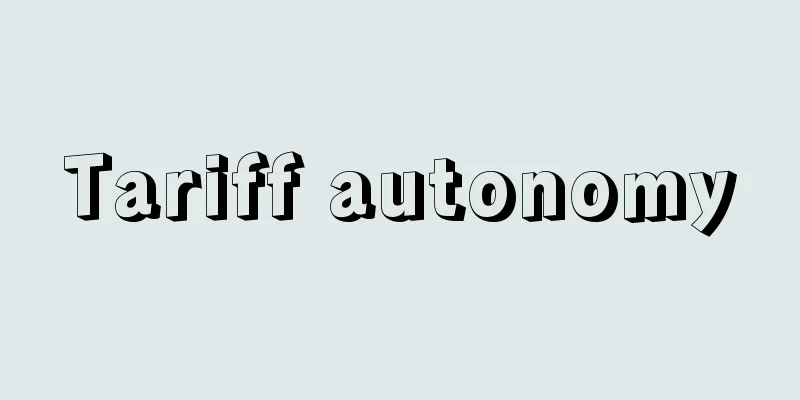Tariff autonomy

|
It refers to the right of a nation to independently determine and operate its tariff system based on its own sovereignty. In principle, tariff rates are set by law, which is called a national tariff rate. Tariffs are usually imposed at a certain rate on imported goods to protect domestic industries or increase tax revenues, and the price of imported goods is raised by the amount of the tax rate, which reduces market competitiveness. As tariffs have a significant impact on the interests of trading partners, it is difficult to impose tariffs unilaterally or for one's own country's own sake these days. In particular, as tariffs are being reduced and trade liberalization is being promoted in forums such as the World Trade Organization (WTO), tariff rates are often determined by agreements between the other country or multiple countries. This does not undermine tariff autonomy, as the agreement is made under the sovereignty of the country. However, in the past, developed capitalist countries have forced low tariff rates on colonies and developing countries through unilateral treaties, limiting and restricting tariff autonomy. It is for this reason that the history of the foreign policies of developing countries has, on the one hand, taken the form of a movement to regain tariff autonomy; a typical example of this would be Japan and China from the late 19th century to the first half of the 20th century. [Kenji Akiyama] JapanJapan, a developing country that opened up to the world in the second half of the 19th century, lost its tariff autonomy by accepting a tariff rate that could not be changed without the consent of the other country in the Ansei Five-Power Treaty of 1858 (Ansei 5). Furthermore, the Edo Tax Revision Agreement of 1866 (Keio 2) forced Japan to adopt a tariff rate of 5% ad valorem, which caused many disadvantages in terms of industrial development. For this reason, the restoration of tax rights as well as legal rights became the central issue of treaty revision after the Meiji period. Successive foreign ministers, carrying the hopes and expectations of the people, attempted to negotiate with the great powers. The government eventually focused its negotiations on the restoration of legal rights, and in 1894 (Meiji 27), Foreign Minister Mutsu Munemitsu concluded a revised treaty, abolished extraterritoriality, and achieved the opening of the interior (implemented in 1899). The remaining restoration of tariff autonomy was achieved in 1911 (Meiji 44) through the efforts of Foreign Minister Komura Jutaro, following victories in the Sino-Japanese and Russo-Japanese wars and the establishment of industrial capital. [Kato Kozaburo] ChinaIn the Treaty of Nanking (Article 10 of the Basic Treaty) in 1842 after the Opium Wars, China was set a unilaterally agreed tariff rate, and in the Treaty of Tianjin in 1858 a transit tax was created that replaced various taxes with a single payment, and customs administration under control of foreigners was started, and furthermore, in the Treaty of Peking in 1860, customs revenue was used as collateral for the Sino-Japanese War and Boxer indemnity, and China not only lost its autonomy in determining import and export tax rates, but also in coastal trade taxes and customs administration. In response to this, the movement to abolish the unequal treaties gained momentum in the wake of the Boxer Rebellion, the Xinhai Revolution, and the Paris Peace Conference, and the Beijing government and others began to take up the issue of regaining tariff autonomy, and a tariff treaty was concluded at the Washington Naval Conference, with new revised rates decided in 1923. However, this was never put into practice, and after the April 12th Shanghai Coup (1927), the Nationalist government concluded treaties with each country individually, and from 1931, import and export taxes based on China's national rates were adopted. However, because foreigners were employed to manage maritime customs, it can be said that complete tariff autonomy was not regained until after the founding of the People's Republic of China in 1949. [Yuzo Kato] [References] | | |Source: Shogakukan Encyclopedia Nipponica About Encyclopedia Nipponica Information | Legend |
|
国家が自らの主権に基づき、自主的に関税制度を定め、運営する権利をいう。関税率は法律によって定められるのが原則で、これが国定関税率である。関税は普通、輸入品に対してある一定の率の税をかけ、自国産業の保護あるいは税収入の増加を図るもので、輸入品はその税率の分だけ価格が引き上げられることになり、市場競争力が損なわれる。このように関税は貿易相手国の利害関係に大きな影響を及ぼすため、今日では一方的あるいは自国本位に関税をかけることはむずかしい。とくに世界貿易機関=WTOなどの場で関税の引下げ、貿易の自由化が進められているため、相手国あるいは多数国間での協定で関税率が決められる場合が多い。これは、自国の主権のもとで協定が行われるのであるから、関税自主権を損なったことにはならない。しかし過去においては、先進資本主義国が植民地や後進国に対して一方的な条約によって低い関税率を強制し、関税自主権を制限、束縛してきた。後進国の対外政策の歴史が、一面では関税自主権の回復運動という形をとってきたのはこのためであり、その典型的な例が19世紀末から20世紀前半にかけての日本と中国とであった。 [秋山憲治] 日本19世紀後半に開国した後進国日本は、1858年(安政5)の安政(あんせい)五か国条約で、相手国の同意なしには変更できない協定税率を受け入れたため、関税自主権を失った。さらに66年(慶応2)の江戸改税約書で、従価5%の関税率を強制され、日本は産業発展上多くの不利益を被ることとなった。このため明治以降、法権とともに税権の回復が条約改正問題の中心となった。歴代の外務大臣は、国民の願望と期待を背負って列強と交渉を試みた。政府はやがて法権回復に絞って交渉し、94年(明治27)外相陸奥宗光(むつむねみつ)は改正条約を締結、治外法権廃止、内地開放を実現した(99年施行)。残る関税自主権の回復は、日清(にっしん)・日露両戦争の勝利と産業資本の確立を踏まえて、1911年(明治44)外相小村寿太郎(じゅたろう)の努力によって実現した。 [加藤幸三郎] 中国アヘン戦争後の1842年、南京(ナンキン)条約(基本条約第10条)において、中国は片務的協定関税率を定められ、58年の天津(てんしん)条約では1回の納税をもって諸課税にかえる通過税がつくられるとともに外国人管理の税関行政が始まり、さらに60年の北京(ペキン)条約、日清(にっしん)戦争、義和団の賠償に関税収入が担保とされるに至って、単に輸出入税率を決める自主権を喪失したばかりか、沿岸貿易税や関税行政などの自主権をも喪失するに至った。これに対して、不平等条約廃棄の運動が、義和団の乱、辛亥(しんがい)革命、パリ講和会議を機にして盛り上がってくると、北京政府なども関税自主権の回復を取り上げるようになり、ワシントン海軍軍縮会議で関税条約が結ばれ、1923年新改定率が決まった。しかし、これは実施をみず、四・一二上海(シャンハイ)クーデター(1927)以後の国民政府が各国と個別に条約を締結し、31年から中国の国定税率による輸出入税が採用されるようになったが、海関(税関)の管理には外国人を雇用していたため、完全な関税自主権の回復は49年の中華人民共和国成立以後のことといえる。 [加藤祐三] [参照項目] | | |出典 小学館 日本大百科全書(ニッポニカ)日本大百科全書(ニッポニカ)について 情報 | 凡例 |
>>: Inertial coordinate system - inertial frame of reference; inertial system
Recommend
Nipponanthropus akashiensis (English spelling)
...The actual bone was burned in 1945 during the ...
Izbrannaya rada (English spelling)
…a priest from Novgorod who was the head priest o...
Black body - kokutai (English spelling) black body
The surface of an object reflects some of the ele...
Wit - Kichi
〘noun〙 Wisdom that can be used quickly according t...
Jisho-Juei Civil War
A nationwide civil war that took place from 1180 (...
American Revolution
A revolution in which the 13 colonies of British ...
Urningirus - Urningirus
...The designs became more diverse, including sce...
Silk gland
An organ found in the larvae of insects of the or...
Cart (car) - car
…In 1956, an American racing car designer created...
Kansei Choshu Shokafu - Kansei Choshu Shokafu
This is a collection of genealogies of samurai fa...
Kanchipuram (English spelling)
A city located in the northern part of Tamil Nadu,...
Carbamates
...It is also called iminourea or carbamidine. It...
Princess Ichikishima
...Also called Ichihime. There is a legend that i...
Makubetsu [town] - Makubetsu
A town in Nakagawa-gun, Hokkaido. Adjacent to Obih...
Takanotsume - Takanotsume
A deciduous tree of the Araliaceae family (APG cl...


![Aconcagua [Mountain] - Aconcagua](/upload/images/67cad284aaa54.webp)






